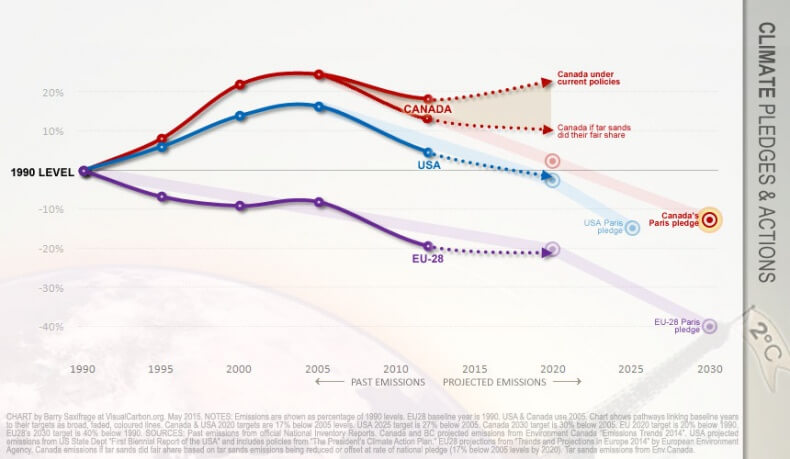With the world watching last week, Canada had an opportunity to prove it was ready to do its fair share in the global fight against climate change. Instead, the federal government released its latest climate commitments to little fanfare, with European-based Climate Action Tracker rating them as “inadequate,” its lowest possible ranking.
On Friday, May 15, the federal government announced its plan for curbing carbon pollution as part of the United Nation’s upcoming global deal on climate action. Participating countries – nearly 200 in total – were asked to submit their individual plans (called INDCs – intended nationally determined contributions) prior to the crucial climate change conference in Paris this December.
For its part, Canada pledged to cut carbon pollution by 30 per cent below 2005 levels by 2030. Climate Action Tracker, an independent scientific analysis of climate action toward the globally-agreed aim of holding warming below 2°C, reports this pledge translates to a 21 per cent reduction below 2005 levels excluding forestry, or 2 per cent below 1990 levels, leaving Canada as one of the biggest climate laggards in the G7.
The United States, by comparison, aims to cut largely the same levels as Canada, but will achieve the goal five years earlier. The European Union has committed to cutting at least 40 per cent below 1990 levels by 2030; Switzerland pledged 50 per cent reductions on 1990 levels by 2030; and Gabon, on the east coast of Africa, pledged 50 per cent cuts by 2025.
The federal government described its commitment as “fair and ambitious” while unveiling the plan.
Climate Action Tracker hasn’t been the only body to take issue with that assessment. The World Resources Institute rated Canada’s INDC submission as “weak,” stating it didn’t “demonstrate nearly as serious a level of ambition as the US.”
“It’s fair to say it doesn’t compare favourably with other developed countries,” said David Waskow, director of the institute’s International Climate Initiative.
The David Suzuki Foundation says the government’s target falls short of what the foundation’s research shows is necessary and feasible for Canada.
Climate Action Tracker’s analysis of the INDC revealed the country is likely to overshoot both its 2020 and 2030 targets unless a lot more policies are put in place to achieve them.
With Canada already off course its goal of cutting emissions by 17 per cent below 2005 levels come 2020, many energy and environmental groups were hoping to see more leadership from the federal government. The Office of the Auditor General of Canada has reported that the main reason the 2020 target will likely be missed is because the federal government hasn’t taken a unifying approach on the issue.
The plan announced last week includes an emphasis on regulating emissions of methane and nitrous oxide, even though the widely-recognized primary source of greenhouse gas pollution is carbon dioxide. It also imposes no limits on the growth of the oil sands in Alberta, already one of the country’s most significant and fastest growing sources of greenhouse gas emissions. Canada is currently ranked among the world’s top 10 largest emitters.
The international scientific community has reached a consensus that only a rapid transition to clean energy systems will allow countries to avoid dangerous climate and economic disruptions from rapid global warming.
Climate Action Network Canada says the federal government could adjust its target to 35 per cent below 2005 levels in order to remain consistent with the scientific consensus on what needs done. The national coalition says further options for strengthening Canada’s climate contribution could include a moratorium on new oil sands development, the complete phase-out of coal power, replacing dirty energy sources with clean, renewable power, and investing heavily in energy efficiency and conservation.
Under its current target, the country risks falling behind and missing opportunities in clean energy innovation and energy efficiency, stated Ecofys, a leading energy and climate policy consultancy.
Despite the lack of a pan-Canadian approach, many provinces have not waited on the federal government to take action on climate change.
In April, premiers signed a 12-point declaration on climate protection that included commitments to transition to a resilient and low-carbon economy. That same week, Ontario announced it was entering a cap and trade system with Quebec and California to control carbon pollution. In doing so, Ontario joined Quebec, British Columbia and Alberta as Canadian jurisdictions who’ve put a price on carbon.
Only a few days earlier that month, 25,000 Canadians marched through the streets of Quebec City to show support for their leaders to act swiftly and fairly on climate change. It was the largest climate-themed march in Canadian history, and carried with it one clear, resounding message for leaders: the people are ready for action to fight climate change — are you?




